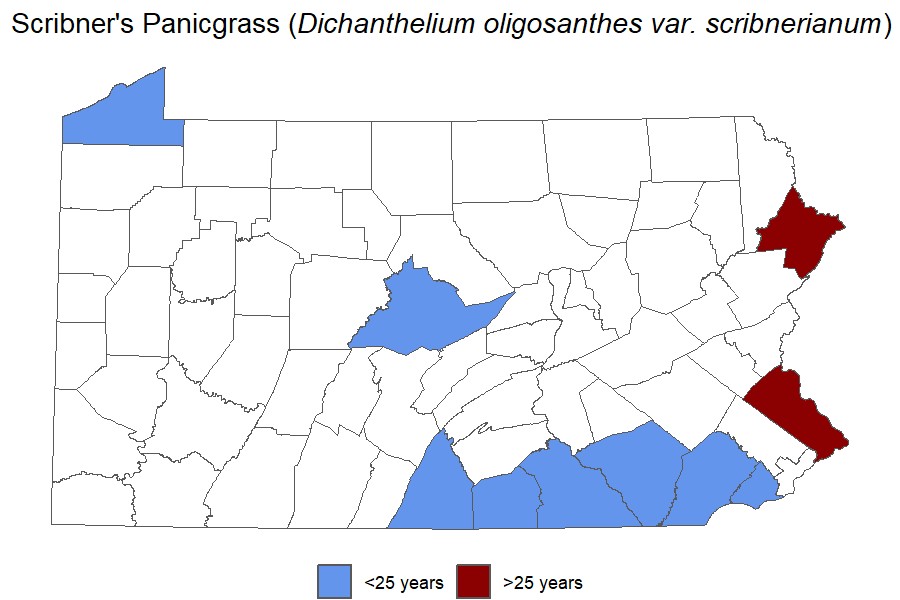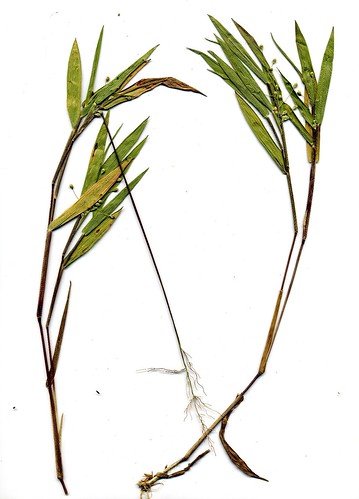 Species Factsheets
Species Factsheets
Dichanthelium scribnerianum
Scribner's Panicgrass
State Status: N
PBS Status: Pennsylvania Threatened (PT)
Federal Status:
Global Rank: G5
![]() rank interpretation
rank interpretation
State Rank: S3
Description
Scribner's Panicgrass is a perennial clump or bunch grass that may grow to 60 cm in height, but is often much shorter. The leaves are alternately arranged, consisting of a basal sheathing portion, which often has a purplish tinge and is frequently hairy, that envelopes the stem and a lance shaped, flattened, and untoothed blade that is 5-13 cm in length and about 12 mm in width, pointed at the tip, and usually somewhat hairy on the lower side. The flowers, appearing first in June and July, and again later in the fall, occur in a compactly-branched inflorescence containing many individual broadly-ovoid spikelets that are about 3-4 mm long and have, at least compared to many of other species in the genus Dichanthelium, relatively thick veins running from top to bottom. There are many species of panic-grass in Pennsylvania, and they are difficult to identify since they mostly require the use of microscopic features to distinguish the species; in general, this species has a combination of relatively broad leaves, prominently-veiny and rounded spikelets, and compact inflorescences.
Rank Justification
Vulnerable in the nation or state due to a restricted range, relatively few populations (often 80 or fewer), recent and widespread declines, or other factors making it vulnerable to extirpation.
Habitat
It grows in open, sunny places, such as grasslands, fields, thickets, and rocky openings, especially on well-drained serpentine, limestone and diabase substrates.
Survey Dates
Vernal terminal panicles May - early July, or late summer or early fall
Distribution
Scribner's Panicgrass has a transcontinental range across North America. In Pennsylvania, it has been documented historically mostly in the southeastern counties.

Management
The viability of populations of Scribner's Panicgrass often requires maintaining early successional conditions and controlling invasive species. Active management, such as periodic mowing or prescribed fire, may be needed to create the proper successional stage and ecological conditions for this species to thrive. Quarrying and habitat loss are threats in some locations.
Conservation Status Map

NatureServe. 2017. NatureServe Explorer: An online encyclopedia of life [web application]. Version 7.1. NatureServe, Arlington, Virginia. Available https://explorer.natureserve.org.
- NatureServe. 2018. NatureServe Explorer: An online encyclopedia of life [web application]. Version 7.1. NatureServe, Arlington, Virginia. Available at https://www.natureserve.org/explorer
- Pennsylvania Natural Heritage Program. 2018.
- Rhoads, A.F. and W.M. Klein, Jr. 1993. The Vascular Flora of Pennsylvania. American Philosophical Society, Philadelphia, Pennsylvania. Rhoads, A.F. and T.A. Block.
- 2007. The Plants of Pennsylvania: An Illustrated Manual. 2nd edition. University of Pennsylvania Press, Philadelphia, Pennsylvania.







